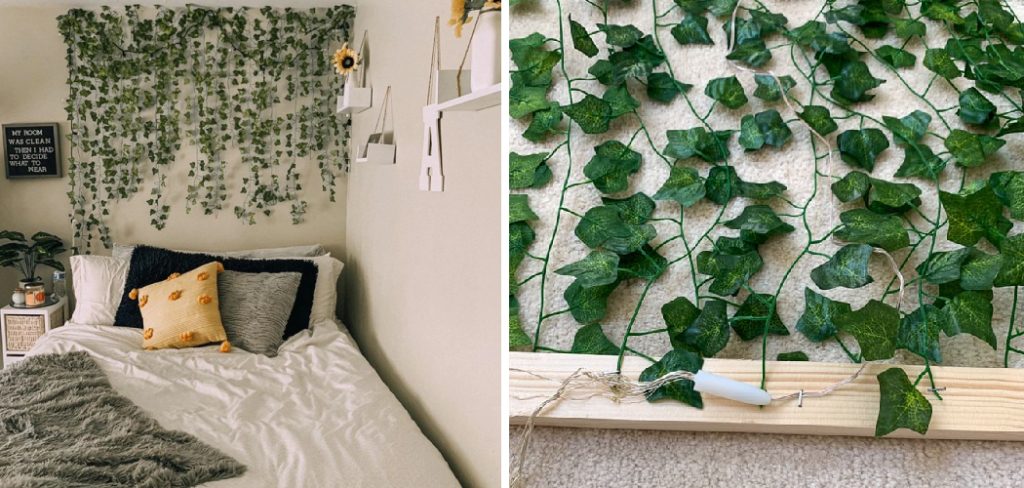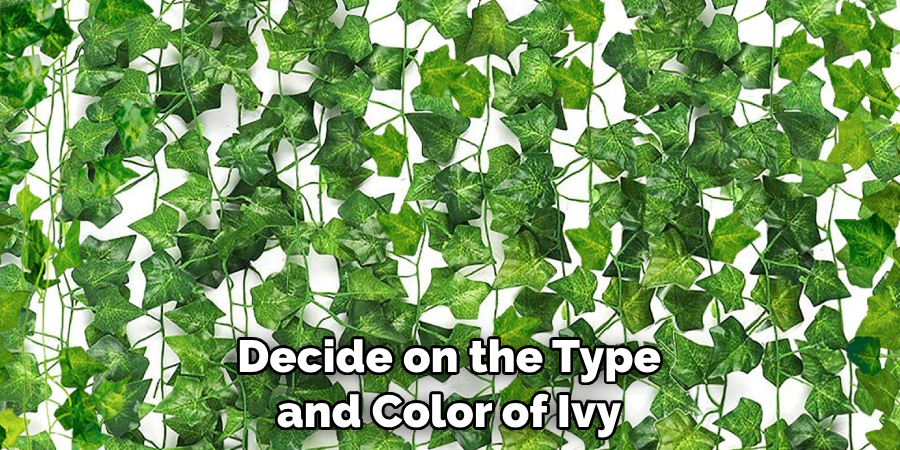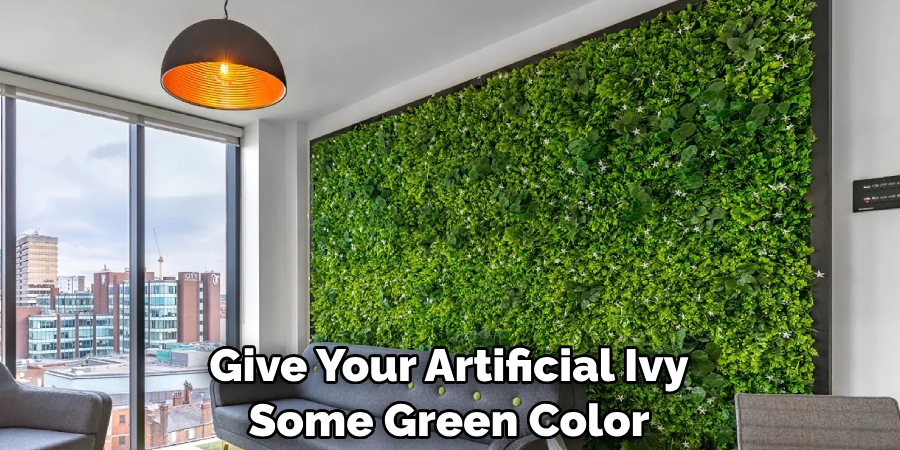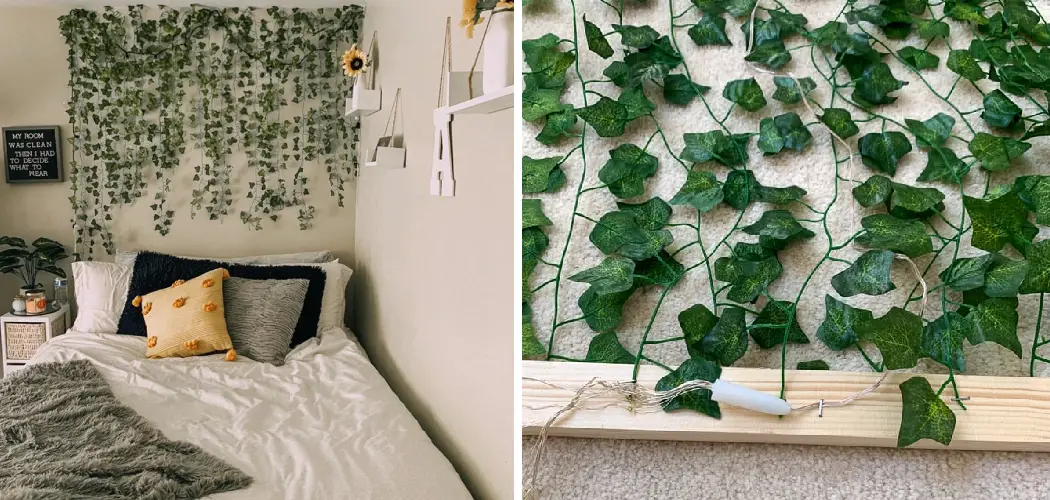Fake ivy is an easy and affordable way to add a touch of greenery to any space. Hanging fake ivy on walls can instantly create a cozy, inviting atmosphere. It’s low-maintenance and looks great year-round! Plus, hanging it properly ensures that the ivy will last for years without becoming damaged or looking unsightly.

One of the most appealing advantages of hanging fake ivy on walls is that it looks great without requiring much maintenance. Because it’s artificial, there’s no need to water the plants or apply fertilizers and pesticides. It also won’t require pruning like real ivy, so you don’t have to worry about trimming it regularly. In this blog article, you can find step-by-step instructions on how to hang fake ivy on walls.
Step-by-step Instructions for How to Hang Fake Ivy on Walls
Step 1: Inspect the Wall
Before you start hanging fake ivy, inspect the wall or area you will adhere to. Ensure there is no dirt or dust and the surface is slightly rough. This ensures that the adhesive tape will stick better when applying the fake ivy leaves to the wall.
Step 2: Measure and Mark
Use a measuring tape to measure and mark the area you want to cover with your fake ivy. This helps to ensure that you will even cover the entire wall or space. Decide on the overall look of your hanging design – which direction the ivy should go in, how thick it should be, etc. Once you decide on a design, draw it on the wall with a pencil.
Step 3: Apply the Adhesive Tape
Use your adhesive tape to secure the starting point of your fake ivy layout. Make sure that you apply enough pressure when pressing down the tape so that it stays in place. Begin at the starting point of your ivy layout and attach each leaf individually. Use thread to tie together some of the leaves or apply a dab of hot glue to hold them in place if needed.
Step 4: Continue Hanging Leaves
Add more fake ivy leaves until you reach the other side of the wall or space. Make sure to space the leaves for a consistent look evenly. If some of your leaves need to be shorter or spaced correctly, use scissors or garden Pruner shears to trim them accordingly.

Step 5: Secure the Edges with Tape
Once all your leaves have been hung, secure the edges with additional adhesive tape to ensure everything stays in place. You can add accessories such as flowers or butterflies to your fake ivy wall for a more natural look. Once you’re done, sit back and admire your work! Your hanging fake ivy will give any room an instant makeover without spending much money.
Following these steps, you can easily hang fake ivy on your walls and give any room an instant makeover. With just some planning and the right supplies, you can create a beautiful display with this versatile plant material.
Tips for How to Hang Fake Ivy on Walls
- Always wear protective gear such as safety goggles, gloves, and long-sleeved clothing to prevent potential injuries while working with the materials.
- Ensure the wall is clean of dust or debris and free of nails or screws before beginning the process.
- Use a stud finder to determine where the studs are before anchoring the ivy.
- When using nails or screws, use a level to ensure all pieces of ivy are straight and even on the wall.
- To securely attach each piece of ivy to the wall, use a special outdoor adhesive designed for fake plants and greenery.
- Ensure that the adhesive has dried completely before continuing to hang more ivy.
- Finally, use a stepladder and keep a steady balance when hanging the ivy on higher walls or at height locations. This will ensure safety and accuracy in installation.
By following these tips, you should be able to safely and successfully install fake ivy on your walls.
What is the Best Way to Plan and Design Your Ivy Wall Pattern?
When it comes to planning and designing your ivy wall pattern, several factors need to be taken into consideration. Firstly, you must decide on the type and color of ivy you want to hang on the wall. You should also consider the size of the area you want covered by ivy; this will help determine how much ivy you need to purchase.

Additionally, think about the wall’s overall look and feel and what aesthetic appeal it should have.
Once these details are sorted out, you can start planning how to hang your ivy on the wall. Use a tape measure or ruler to plan where each vine should be placed if possible. This will help you create an even design and prevent unnecessary overcrowding. When selecting a method of hanging the ivy, choose something durable and secure enough to withstand any wind or movement.
Is There a Specific Method for Measuring and Cutting Fake Ivy Before Attaching It to the Wall?
Measuring and cutting fake ivy before attaching it to the wall is an important step that should be considered. First, measure the area of the wall where you plan to hang the ivy. If possible, use a yardstick or measuring tape for precision. Consider any decorative elements like window frames or other obstructions when measuring.
Once you have the measurements, you can use scissors or a craft knife to cut the strips of faux ivy to size. Make straight cuts and avoid jagged edges, giving your wall decoration a more polished look. Once the pieces are cut, attach them to the wall with command strips or hot glue.
For added security, use nails or tacks to secure the ivy firmly. With patience and care, you can easily hang your fake ivy on any wall for a stunning visual effect.
What Are the Common Mistakes to Avoid When Hanging Fake Ivy on Walls?
Hanging fake ivy on walls can become challenging, especially if you need to familiarize yourself with the process. To help ensure your faux ivy looks its best, it’s important to avoid common mistakes when hanging it. Here are a few of the most common blunders to watch out for:

- Poor Measurements: When measuring for your faux ivy, it’s important to take precise measurements and ensure enough material to cover the entire area. Failing to measure accurately can lead to coverage gaps or too much material.
- Poor Placement: When placing your fake ivy on a wall, be sure it is properly aligned and symmetrical. This will help create an even look and help the ivy fit in with the environment. Additionally, consider any fixtures or furniture that may interfere with placement.
- Poor Adhesion: When affixing your ivy to a wall, using a good adhesive that can hold up for years is important. If you opt for tape, ensure the adhesive is strong enough for regular use. Additionally, smooth the ivy down so that it adheres properly and looks good.
You can ensure a successful installation by avoiding these common mistakes when hanging your fake ivy on walls. With some preparation and patience, you can create a beautiful artificial ivy wall that will last years.
Is There Any Special Care or Maintenance for Fake Ivy After It is Hung on Walls?
Once you have successfully hung fake ivy on your walls, very little special maintenance needs to be done to preserve the plant’s aesthetic. Fake ivy can last for years without any special care. But if you want to keep it looking and feeling fresh, here are a few tips:
- Avoid placing the plants in direct sunlight or near sources of heat. This can cause the artificial ivy leaves to fade and become brittle.
- Dust or lightly vacuum your fake ivy periodically, especially in a high-traffic area of your home.
- If the faux vines start to sag or droop, you can re-shape them by lightly applying heat from a hair dryer and then reforming the ivy leaves into your desired shape.
- If you want to give your artificial ivy some green color, it can be sprayed with soft water every few weeks.

With these simple steps, you can ensure your fake ivy stays vibrant and fresh year-round.
Conclusion
The main disadvantage of hanging fake ivy on walls is that it can be difficult to make it look realistic. Fake ivy often needs to be more bright and plastic-like, which makes it hard to blend in with natural elements. Additionally, the adhesive used to stick the ivy onto the wall may not be strong enough to keep the vines up for a long time, and they may begin to sag or even fall off.
In conclusion, hanging fake ivy on walls is a great way to add some greenery and beauty to your home without worrying about maintaining real plants. Whether you’re using adhesive strips, nails, or screws, there are plenty of ways to hang fake ivy with minimal damage to the wall securely.
This article has been beneficial for learning how to hang fake ivy on walls. Make Sure the preventive measures are followed chronologically.
You Can Also Check This Out to How to Get Straight Edges Crochet

